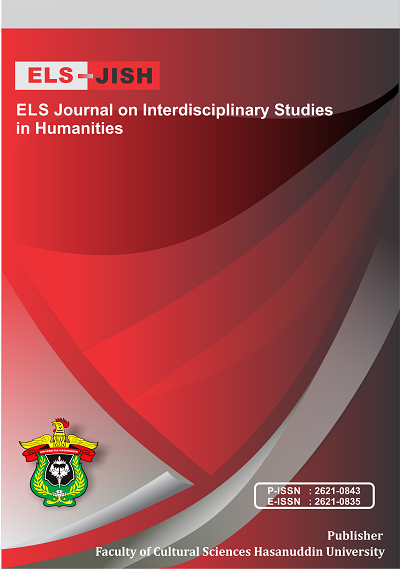An Analysis of Cultural Terms Translation in ‘Chef’ Movie Script
DOI:
https://doi.org/10.34050/elsjish.v5i2.21693Keywords:
Cultural terms, translation technique, quality assessmentAbstract
The focus of this study was on the translation of cultural terminology found in the "Chef" movie script. The goals were to determine the cultural category, the translation techniques used, and the translation quality. The data for this analysis were words, phrases, and sentences, hence the descriptive qualitative method was utilized. Purposive sampling was used by the researchers, and got 28 sets of data to analyze. The movie script contained four out of five cultural categories: material (75%), concept and social organization (14.28%), ecological (7.14%), and gesture and habit (7.14%). (3.57%). Only four of the 18 translation strategies were used to translate the cultural terms: pure borrowing (75 %), literal translation (39.28 %), established equivalence (7.14 %), and adaptation (7.14 %) (3.57%) The quality of the translation study revealed that 27 data (96.42 %) were accurately translated into Indonesian, and that 28 data (100%) were acceptable and highly readable.
References
Andini, C., Sosrohadi, S., Fairuz, M. Dalyan, Rahman, F.F., Hasnia. (2022). The Study of Japanese Women in the Facial Treatment Advertisement: A Semiotics Perspective of Pierce’s Theory. ELS Journal on Interdisciplinary Studies in Humanities. 5(2), 337-347.
Astiantih, S., Rahman, F., & Makka, M. (2017). From Narrative Slave to Movie: Adaptation Theory. Imperial Journal of Interdisciplinary Research (IJIR), 3(6), 659-663.
Barkan, S. (2012). Sociology: Brief Edition. Maine: Unnamed Publisher.
De Vany, A. (2006). The movies. Handbook of the Economics of Art and Culture, 1, 615-665.
House, J. (2017). Translation: The Basics. Routledge.
Latief, M. R. A., Saleh, N. J., & Pammu, A. (2020, October). The effectiveness of machine translation to improve the system of translating language on cultural context. In IOP Conference Series: Earth and Environmental Science (Vol. 575, No. 1, p. 012178). IOP Publishing.
Laerd. (2012). Purposive sampling. Retrieved from http://dissertation.laerd.com/purposive-sampling.php
Manzini, M. (2016). Spanglish: Two languages and a unique perspective. An analysis of three short stories by US Latinos. Università Ca’ Foscari Venezia
Martinez, A. (2011). Multicultural Spanish dictionary: How everyday Spanish differs from country to country. Taylor Trade Publications.
Molina, L., & Hurtado Albir, A. (2002). Translation techniques revisited: A dynamic and functionalist approach. Meta: Journal des Traducteurs/Meta: Translators' Journal, 47(4), 498-512.
Nababan, M. R. (2012). Pengembangan Model Kualitas Penerjemahan. Kajian Linguistik dan Sastra, 24(1), 39-57.
Newmark, P. (1988). A Textbook of Translation. London: Prentice Hall.
Prihandoko, L. A., Anggawirya, A. M., & Rahman, F. (2021). Students’ Perceptions Towards Autonomous Learners Concept in Academic Writing Classes: Sequential Mixed-Method. In International Joined Conference on Social Science (ICSS 2021) (pp. 487-491). Atlantis Press.
Rahman, F. (2017). Cyber literature: A reader–writer interactivity. International Journal of Social Sciences & Educational Studies, 3(4), 156.
Rahman, F. F., & Rahman, F. (2019). Translation or Intertextuality: A Literature Comparative Analysis of “The Young Dead Soldiers Do Not Speak” by Archibald MacLeish and “Krawang Bekasi” by Chairil Anwar. Elsya: Journal of English Language Studies, 1(3), 110-117.
Rowley, G., & Purcell, K. (2001). ‘As cooks go, she went’: is labour churn inevitable?. International Journal of Hospitality Management, 20(2), 163-185.
Sukmawaty., Andini, C., Rahman. F.F. (2022). The Shift of Honorifics due to The Promotion As A Government Official: Comparative Study. ELS Journal on Interdisciplinary Studies In Humanities, 5(1), 166-176.
Webster, M. (2021). The Real Story of ‘Fake News’. Recuperado el, 15.
Widyahening, E. T., & Wardhani, N. E. (2016). Literary works and character education. International journal of language and literature, 4(1), 176-180.
Wilkinson, D. (2000). The Complete Guide to Practitioner Research. London: RoutledgeFalmer.
Downloads
Published
How to Cite
Issue
Section
License
Copyright (c) 2022 Intan Firdaus, Gayus Immanuelle Putranda Nauly

This work is licensed under a Creative Commons Attribution-NonCommercial-ShareAlike 4.0 International License.






